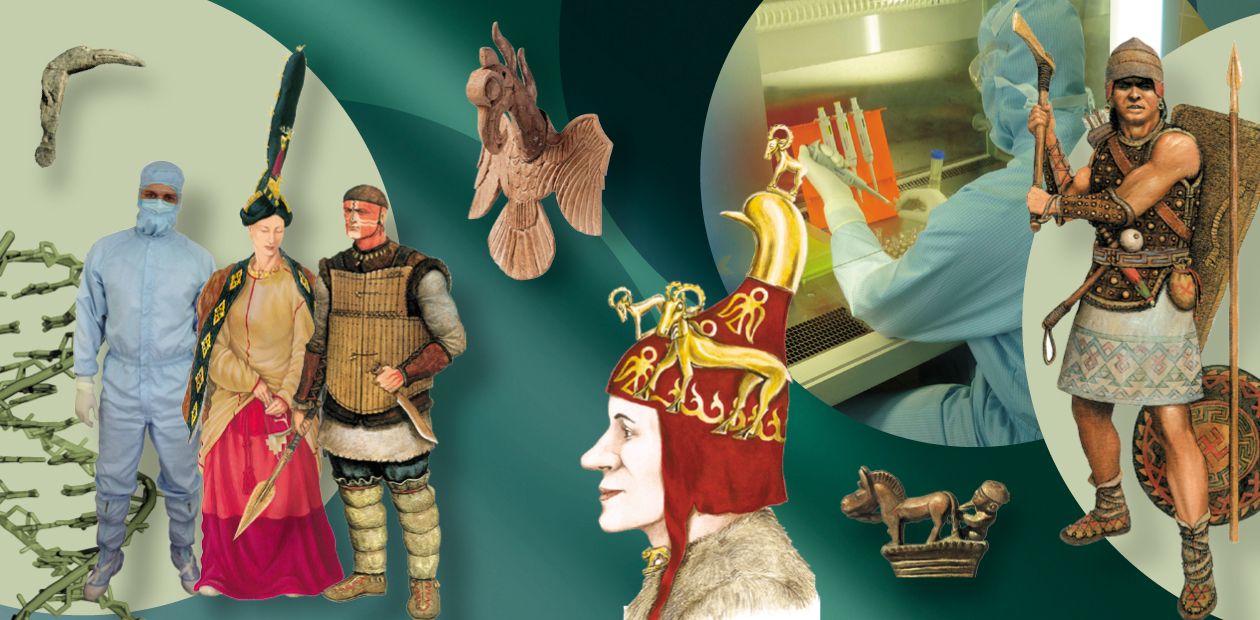Hunters for Ancient Genes
Genetic Chronicle of the West Siberian Population in the Paleometal Age
Paleogenetics, which was born as an independent field of study only in the early 1980s, has now matured into a full-fledged discipline within human molecular genetics. Paleogeneticists have their own arsenal of methods to resolve almost any issue associated with robust analysis of ancient human DNA.
This opens up prospects for cooperation between researchers specializing in paleogenetics, archaeology, and physical anthropology on a wide range of issues---from determining the kinship, gender, and phenotypic characteristics of individual representatives of an ancient population to reconstructing the large-scale ethnogenetic processes that took place in different parts of Siberia in the Holocene
For science, the man has always been the most fascinating object of research, studied in an intense and versatile way. In recent years, increasing attention has focused on the advances in molecular genetics, a field that studies the genetic diversity of human populations and the principles of organization and functioning of human genome. The success of the international program “Human Genome” made molecular genetics a leading research area among all biomedical research.
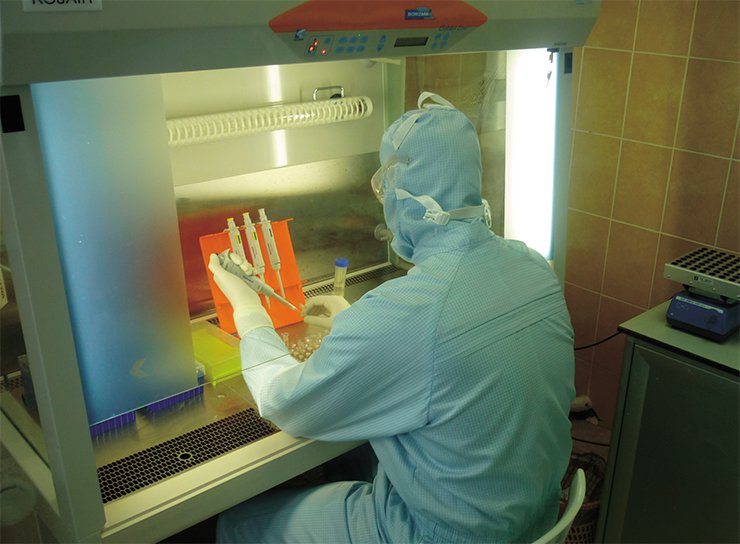
However, despite all these achievements, there is a huge number of unresolved problems related to the origin and evolution of the human species and human physiology. Therefore, scientists are always in search of new methods and approaches. The continuous improvement of methods for obtaining and analyzing the DNA structure has made it possible to conduct genetic studies using samples from human remains of different ages, even from fossilized materials, as well as from currently living individuals.
DNA aged thousands of years
Paleogenetics as an independent field of study was born only in the mid-1980s, when scientists performed the first analysis of a fragment of the mitochondrial DNA (mtDNA) extracted from the museum remains of quagga, an extinct representative of a species closely related to the horse and zebra, about 140 years old (Higuchi et al., 1984). Next year, the first paper was published on the analysis of DNA from ancient human remains, a 2,400-year old Egyptian mummy (Paabo, 1985).
 In the second half of the 1980s, molecular geneticists began to apply a new method – the polymerase chain reaction (PCR), which allowed them to obtain a virtually unlimited number of copies of a short DNA fragment even for extremely low concentrations. This innovation expanded the range of sources for the isolation and analysis of ancient DNA and led to a boost in the number of publications on molecular genetic analysis of fossil remains of not only humans but also animals, plants, and microorganisms that lived hundreds, thousands, and even millions of years ago (Thomas et al., 1989; Golenberg et al., 1990; Cano et al., 1992).
In the second half of the 1980s, molecular geneticists began to apply a new method – the polymerase chain reaction (PCR), which allowed them to obtain a virtually unlimited number of copies of a short DNA fragment even for extremely low concentrations. This innovation expanded the range of sources for the isolation and analysis of ancient DNA and led to a boost in the number of publications on molecular genetic analysis of fossil remains of not only humans but also animals, plants, and microorganisms that lived hundreds, thousands, and even millions of years ago (Thomas et al., 1989; Golenberg et al., 1990; Cano et al., 1992).
However, the initial optimism aroused by the visible potential of this research area and the seeming simplicity of the methods soon vanished owing to the studies into the DNA degradation processes, especially, the contamination of ancient samples with modern DNA, as they may lead to false research results. Subsequent studies on the biochemistry of the DNA degradation processes after the body’s death and the effect of different environmental conditions on DNA preservation provided evidence that DNA suitable for analysis can “survive” in remnants thousands of years old even in a temperate climate zone (Poinar et al., 1996). Since that time, proving the authenticity of experimental results has become the primary task of every paleogenetic study.
The development of methods of high-performance parallel DNA sequencing has become an important milestone in the development of paleogenetics. These methods allow researchers to obtain a lot of genetic information from a minimum amount of the initial DNA-containing material, which helps avoid the destruction of the unique sample during the analysis. These methods have almost equalized the informative potential of ancient and modern DNA samples.
Thus, nowadays, paleogenetics has developed into a full-fledged discipline within human molecular genetics. Paleogeneticists have their own arsenal of methods to resolve almost any issue associated with robust analysis of ancient human DNA. One can investigate the almost complete genome of an ancient individual as well as an individual “letter” (position) or a short part of ancient DNA. However, the analysis of ancient DNA is more expensive than that of modern DNA. Moreover, paleogenetic methods cannot be applied to any material because some of them contain highly degraded or heavily contaminated DNA; the latter is particularly common in the remains of anatomically modern humans. However, most of the well-preserved paleoanthropological materials are quite suitable for paleogenetic studies.
It all started with “Pazyryk”
The Institute of Archaeology and Ethnography SB RAS (IAE, Novosibirsk) was one of the first research institutions to engage in paleogenetic studies, when the new science was making its first steps. In this area, it became partners with the Institute of Cytology and Genetics SB RAS (ICG), its nearest neighbor in Novosibirsk Akademgorodok.
The starting point of the joint paleogenetic studies was the international research program “Pazyryk,” implemented in the mid-1990s. At that time, Academicians Anatoly Derevyanko (IAE Director) and Vladimir Shumny (ICG Director) initiated molecular genetic studies of the mummified remains of the Pazyryk culture bearers from the unique “frozen” burials on the Ukok plateau in the Altai Mountains (Russia). The burials had been discovered and explored by the IAE expedition teams headed by Natalia Polosmak and Vyacheslav Molodin. In that period, paleogenetic studies were conducted by the team of molecular geneticists from the ICG under the direction of Mikhail Voevoda, Corresponding Member of the Russian Academy of Medical Sciences, and Aida Romashchenko, Cand. Sci. (Bio.). On the part of the IAE, the studies were headed by Vyavheslav Molodin.
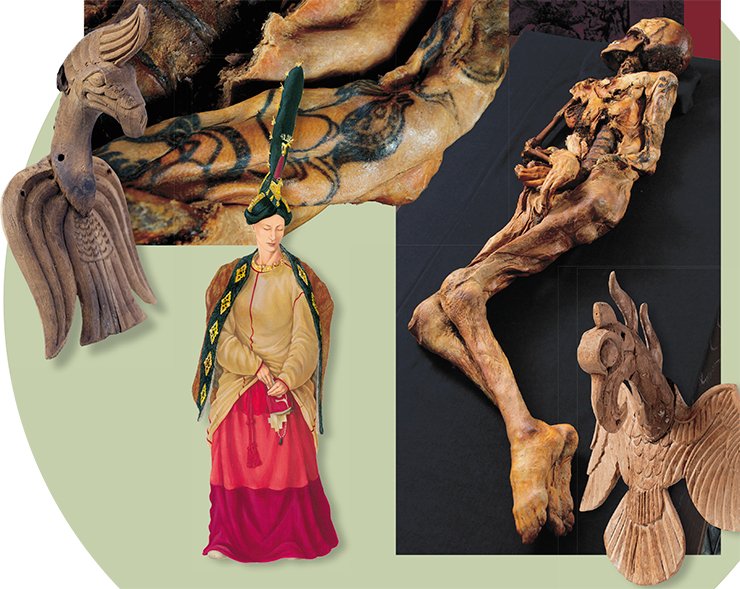
The unique preservation of the paleoanthropological material from the burials found in permafrost allowed researchers to analyze the mitochondrial DNA of several individuals (Voеvoda et al., 1998). The studies performed by the cross-institute collaboration formed the core of a series of integration projects on paleogenetics, which were organized by the SB RAS. The integrated analysis of the archaeological, anthropological, and paleogenetic data was published in a major overview and detailed study on the various aspects of the history of the Pazyryk population in the Altai Mountains (Molodin et al., 2003).
Since the mid-2000s, the scope of paleogenetic research at the IAE and ICG has substantially expanded to involve new materials, explore new avenues of research, and tackle more complex tasks. During this period, the institutes have taken major decisions to develop the infrastructure for paleogenetic studies at the ICG (supervised by Academicians Nikolai Kolchanov and Vyacheslav Molodin) and build a team of young paleogeneticists who receive special training for the ICG–IAE collaborative studies on ancient DNA. By 2009, the collaboration had started experimental works in the new dedicated premises for paleogenetic research at the ICG. In 2010, a decision was made to establish a special research department for paleogenetic studies, leading to the establishment of the Interinstitutional Center of Molecular Paleogenetics (ICG), which is now headed by Cand. Sci. (Bio.) Alexander Pilipenko. The research staff are young paleogeneticists, who have been trained during the implementation of the IAE–ICG joint research projects.
Currently, the IAE and ICG continue to develop the infrastructure and instruments for joint research. The achievements include a new laboratory building that meets all modern standards, an increase in the number of researchers working at the Interinstitutional Center of Molecular Paleogenetics, and a more intense collaboration with Russian, and international science institutions interested in conducting paleogenetic studies.
Baraba as a paleogenetic model
The close cooperation of our specialists in paleogenetics, archaeology, and physical anthropology during all the phases of the research process allowed us to obtain original, highly objective and reliable data on the ethnic history of the population of Siberia and other regions of Eurasia from the Stone Age to the modern and late modern period. The range of issues that can be explored by paleogenetic methods is extremely wide – from determining the kinship, gender, and phenotypic characteristics of individual representatives of an ancient population to reconstructing the large-scale ethnogenetic processes that took place in different parts of Siberia in the Holocene.
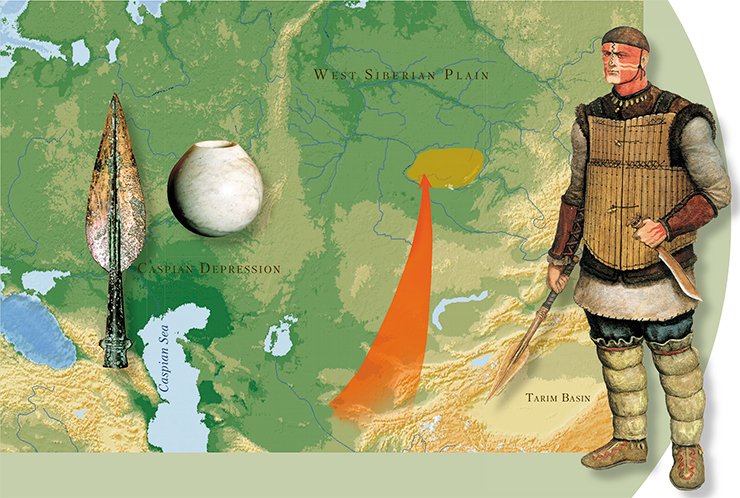
Today, we can directly estimate the gene pool in ancient population groups that were replacing one another over a long chronological period and compare the genetic composition of a population in different historical epochs. Materials for these studies are collected from sufficiently local territories to ensure the representativeness of the samples. The success of this work depends almost entirely on the joint efforts of different experts in the selection of the most appropriate material and the subsequent interpretation of the data. This a highly laborious work, but it provides an accurate pattern of population genetic changes. This pattern can be compared with the data from other sciences to gain an insight into the historical processes leading to these changes.
The Baraba forest-steppe, a territory in the forest-steppe zone between the Ob and Irtysh rivers, was the pilot region for the implementation of this approach. This region had been intensively researched by IAE archaeologists for over 40 years to develop a classification system for the ethnic and cultural groups of the Holocene, which reflects the chronology, material culture characteristics, possible directions of migrations, and cultural and demographic relations (Molodin, 1983). In addition, researchers had already collected extensive and sufficiently well preserved anthropological material.
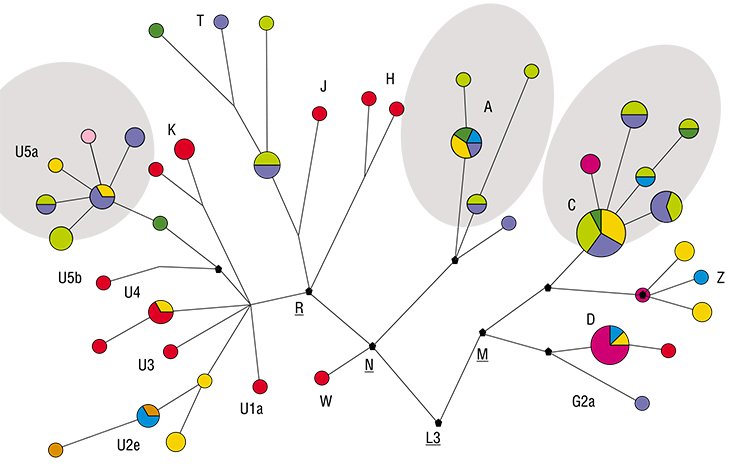
By now, researchers have analyzed the mitochondrial DNA gene pool (which is transmitted only maternally and reflects, first of all, the history of the female part of the population) for the Baraba population of different historical periods: the Neolithic Period, Bronze Age, Iron Age, and the Middle Ages. The analysis revealed many details of the genetic history of the regional population.
Natives and migrants in West Siberia
The Neolithic populations of the Early Metal Age, who lived in Baraba from the early 4,000 BC to 6,000 BC, are the earliest groups of the Baraba population to be studied by paleogenetic methods. These groups had served, for about 5,000 years, as a genetic base of all the subsequent population processes.
The mitochondrial gene pool of this Baraba population was found to have relic features making it similar to the gene pools of the hunter-gatherers inhabiting the vast territories of Northwestern Eurasia. These features had likely been inherited from the people of the modern physical type, who had inhabited the region as far back as in the Upper Paleolithic. Interestingly, in Baraba these features persisted for a long time, until the beginning of the developed Bronze Age, which is why scientists were able to detect them (Molodin et al., 2012).
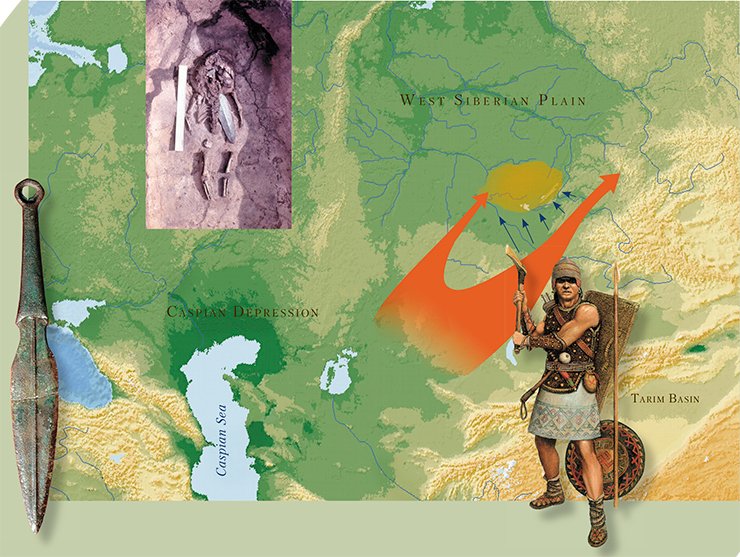
A major scientific achievement was the discovery of genetic evidence for a long independent evolution of the West Siberian population. This hypothesis was put forward by anthropologists as early as in the middle of the last century, but until recently, there was no genetic proof. The study of the mtDNA gene pool of modern populations detected alien elements that penetrated from other territories. The studies conducted by Novosibirsk paleogeneticists have proved that the specific mtDNA haplogroup A10 is a “local” component. It appears to have come to West Siberia before the Holocene epoch, i.e., more than 10,000 years ago, and have evolved here over several millennia (Pilipenko et al., 2015).
Now we know why researchers were unable to make such a discovery from the data on the modern populations. Over the last millennia, West Siberia was flooded with migrants moving from the west and east, which attenuated the relic structure of the gene pool. However, these late migration flows themselves proved to be an exciting object of research.
Over the last 4,000 years, each of the main migration waves, which were first determined from archaeological and anthropological data, has had its effect on the gene pool of the regional population as well as the material aspects of people’s lives. For example, the large-scale wave of migration of the Andronovo (Fedorovo) population, who came here presumably from the territory of Kazakhstan in the first half of the 2nd millennium BC, led to a drastic change in the material culture of the population, who had been developing on local resources for thousands of years. However, the changes at the level of mitochondrial DNA were much less apparent.
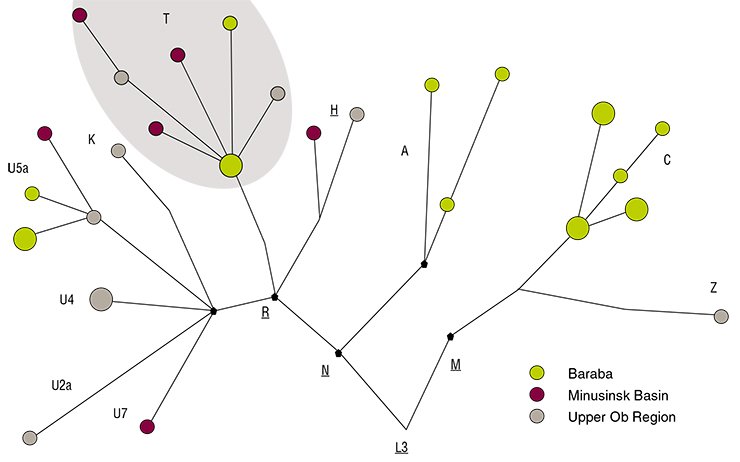
We, however, have been able to detect the genetic marker of this migration wave – the T haplogroup – and the changes in the occurrence of some other haplogroups, which is evidence of migration activity in the south of Siberia. However, many of the components of the mitochondrial gene pool remained unchanged. This gives reason to believe that the local population was actively engaged in marital bonding with the alien representatives of the Andronovo culture. Moreover, the first data on the nuclear genome, i. e., the male Y-chromosome, give reason to believe that these contacts were typical mainly of the alien male population and the local female contingent. On the whole, these models can provide data not only about migrations as such but also about the features of the cultural and genetic interactions between different populations.
Southerners on Chicha
Thus, by analyzing the changes in the gene pool, we can infer about the patterns of the territorial expansion and the mixing of the local and alien population. In this sense, of great interest are the results of studying the famous ancient city Chicha 1, also located in Baraba on the shores of Lake Baraba.
At the beginning of the 1st millennium BC, there was a large settlement with streets and a complex system of fortifications in the form of walls and ditches. Archaeologists have found traces of different cultural groups, and the city organization has many features typical of more southern centers of civilization. All this suggests that this city was a hub bringing together different cultures and communities.
We were able to analyze the mtDNA of a small sample of Chicha 1 population. The specimens for the analysis were taken from a nearby necropolis and the skeletons of children who were buried under the floors of many houses in different parts of the settlement. It turned out that the population of Chicha-1 was genetically very different from the previous local population and was close to that of Central and Southwest Asia. Obviously, in this period, Siberia experienced the first echoes of the large-scale population processes that had been initiated in the steppe zone of Eurasia by the early nomads. This conclusion agrees well with the archeological and anthropological data.
Further studies have shown that this “invasion” of the genetically contrasting population from the south was a comparatively lasting process. The Sargatian population of the West Siberian forest-steppe (the second half of the 1st millennium BC to the first centuries of the 1st millennium AD) also proved to be predominantly southerners in origin. Since archaeological evidence suggests that the Sargatians could have born relationship to the Sarmatian world, our next step was to study the Sarmatian populations of the Lower Volga...
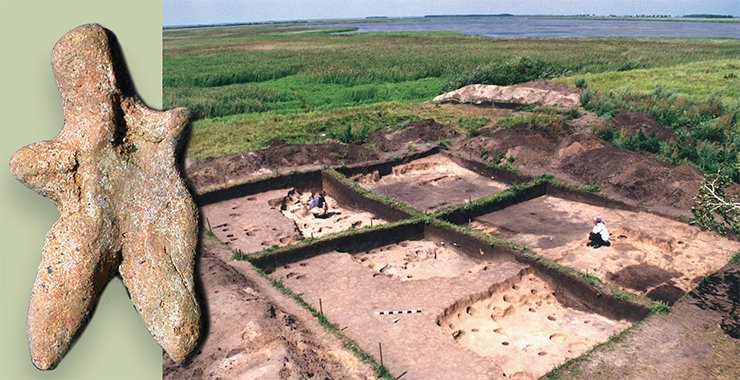
All our results suggest that the south of Siberia was an “arena” for key events in the history of many of the peoples inhabiting Central and Northern Eurasia. Now we have initiated a large-scale study of the ancient population of this region using the Y-chromosome markers to obtain data on the male part of the gene pool and, thus make a complete picture. The approach, which has been tested in Baraba, is now used in other regions of Siberia, in particular, the Minusinsk Basin and the Altai Mountains.
Another approach to ethnogenetic reconstructions, which we are now using for the nomads of Eurasia, is the analysis of synchronous materials obtained from vast territories. In this case, we investigate the paleogenetic materials for the nomadic tribes of the early Iron Age, Hun-Sarmatian period, and early Middle Ages, from not only Siberia but also many parts of the Eurasian steppe zone and neighboring regions, from Central Asia to Eastern Europe. We are working on this project together with colleagues from the Johannes Gutenberg University of Mainz (Germany); the German team is led by Prof. Dr. Joachim Burger.
How the female Amazon warrior... changed sex
For archaeologists, it is very important that paleogenetics allows accurate determination of the sex and kinship of ancient individuals.
Previously, the sex of ancient individuals was determined by physical anthropology methods (i. e., skeletal morphology) and from the analysis of the archaeological context, e. g., the burial inventory. However, these methods have their limitations: e. g., it might be very difficult, sometimes impossible, to determine the sex of a young individual or child from the skeletal remains, or in the case of the poor preservation of a skeleton.
As regards the degree of kinship, it is almost impossible to determine it from anthropological data. Researchers succeeded only in those exceptional cases where the buried individuals had some rare, genetically determined abnormalities of the skeleton. Archaeologists usually make reconstructions using the simplest models of kinship. If they study a burial of a woman and child, then they assume that they are a mother and her child. This was really so in the case of Olon-Kurin-Gol-6 Tumulus 1 (northwestern Mongolia), where this fact was confirmed by paleogenetic analysis (Pilipenko et al., 2010). However, there may be other situations where paleogenetics is the only tool to obtain objective data in this complex and largely speculative field of archeology.
A striking example supporting this view is the results of the study of the skeletal remains from Ak-Alakha 1 Tumulus 1, which were discovered in 1990 on the Ukok Plateau in the Altai Mountains. This paired burial with rich inventory and a full range of weapons contained, presumably, the remains of a mature man and a young girl, both of whom belonged to the elite of the Pazyryk society.
Since the bodies had not been mummified, their sex and age were established from the skeletal remains using physical anthropology methods. The sex of the person buried in the first woodblock, a man aged 45 to 50, raised no doubt, but the individual buried in the second woodblock was a different story... Although anthropologists were convinced that those were remains of a girl aged 16 to 17, they emphasized her “unfeminine” features: “…the skull is very large and looks massive... the lower jaw is very massive... The postcranial bones are very long, almost the same in terms of absolute size and massiveness as male skeleton bones... The body length is very large” (Chikisheva, 1994).
The anthropologists’ conclusions were confirmed by the features of the accompanying inventory: the woodblock, the wooden cushion, the quiver, etc.—all these items were smaller in size, compared to the man’s burial. In addition, researchers found near the pelvis of the buried person 34 cowrie shells, which might have been belt decorations. Shells were an extremely rare find in Pazyryk graves. They were usually found in handbags together with beads and seeds of exotic fruits; researchers believed that the shells served as amulets. In addition, these shells were known to have a semantics of a symbol of female fertility.
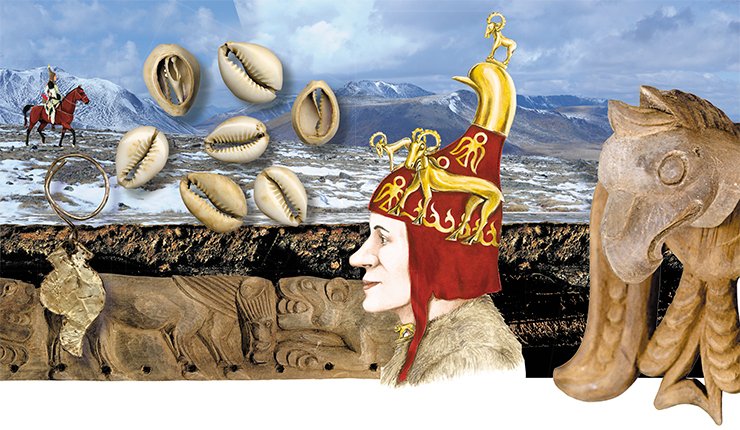
The buried persons also had different hairstyles: there was long dark brown hair on the man’s skull, and his forehead and crown were open. On the skull of the second person, there was a little thin braid.
Discovering the burial of this girl—a rider and warrior—became one more argument for the hypothesis that the Pazyryk society may have had a tradition of teaching young girls from the elite prone to the art of war how to use weapons (before they got married), although this was a unique case for the Pazyryk culture (Polosmak, 2001).
However, 25 years later, to clarify the phylogenetic and phylogeographic characteristics, the possible degree of kinship, and the sex of the buried persons, scientists investigated their remains by paleogenetic methods.
The main method was molecular genetic analysis with four systems of genetic markers (mitochondrial DNA, a polymorphic fragment of the amelogenin gene, STR-loci of autosomes, and STR-loci of the Y-chromosome). The investigations were carried out at the ICG (Pilipenko, Trapezov, and Polosmak, 2015).
In the experiments, scientists have obtained ample evidence for the different degrees of preservation of the DNA in the remains of the two individuals. The preservation of the DNA in the remains of the young individual was much lower than in those of the aged man. However, scientists have obtained reliable molecular genetic evidence that both of the individuals from Ak-Alakha 1 Tumulus 1 were male, although these data are at odds with the physical anthropology results for the gender identification of the younger individual.
Scientists believe that “...it could be due to the young age of the deceased individual: gender identification of remains of adolescents from the skeleton morphology may, in some cases, be very difficult.” However, the genetic analysis of this individual was not that simple either. The new data were a reason for revising the possible kinship between the buried persons. Previously, researchers believed that this paired burial of an aged man and a young woman was a burial of spouses or a father and a daughter.
Reconstructing the degree of kinship of individuals buried in collective graves or burial sites and determining their sex is one of the most promising areas for the application of paleogenetic methods in archeology. By analyzing uniparental inheritance markers (mtDNA and Y-chromosome), we determined the probability of close kinship between the individuals from the paired burial in both the female and male lines. The data on the profiles of autosomal STR-loci show that the investigated individuals were not direct relatives; in this case, taking into account the sex of the buried, they could not have been father and son (Pilipenko, Trapezov, and Polosmak, 2015).
Having established a sufficiently close kinship between the buried persons (they could have been uncle and nephew), the geneticists have confirmed the conclusions made in 1994 by Balueva, who created reconstructions of the faces of the two individuals: “From the front, the noses of the man and woman from the Ak-Alakha 1 burial site are very similar... The chins of the male and female skulls are very similar in shape.”
Another piece of evidence for the close kinship of the individuals was the similarity of the pathological processes in the cervical vertebrae, which was reported by Balueva: “...the man had spondylosis of the cervical vertebrae, which obstructed the head movement; in the female skull in the area of articular condyles of the occipital foramen, there are traces of the same deformation processes that we have mentioned above. The identical signs of illness may indicate a kinship of those buried in the mound.”
There is another striking fact: by the time of his death, the older man had long been a sedentary disabled person, unable to get on a horse on his own. According to Chikisheva, his skeleton had signs of severe damage with one of the varieties of chronic polyarthritis: “The general pathological process involves almost the entire osteoarticular apparatus... the disease of the deceased individual can be identified as ankylosing spondylitis, also known as Bekhterev’s disease... The etiology of the disease is unknown... The disease affects mostly males and begins in the second or third decade of life.” His death could have been due to the development of the disease. As to the cause of the young man’s death, neither anthropologists nor geneticists have been able to find it yet.
Today, the methods and approaches of paleogenetics have become a powerful tool with which archaeologists can trace the actual demographic processes in ancient populations. Moreover, researchers can use them to obtain or update information about specific individuals in those cases where the conventional methods of archeology and anthropology are not successful, which has been proved by the works of the interinstitutional team of paleogeneticists from Akademgorodok.
From the perspective of genetics and archeology, it is equally relevant and promising to study the molecular-genetic mechanisms of human adaptation both to the natural environment and to the level of economic development and material culture. Indeed, it is important to know how people in Siberia were adapting to the harsh climatic conditions and to the changes in dietary patterns related to their cultural development. For example, now we are engaged in a study of the lactase gene, which is responsible for the ability to digest lactose in adulthood.
No less interesting are reconstructions of the phenotypic parameters of ancient population representatives, e.g., a particular pigmentation of eyes and hair. Currently, paleogenetics offers ever more opportunities for the reconstruction of the “portraits” of ancient humans in the literal and figurative sense.
In addition to human remains, our team pays particular attention to the study of the remains of animals from archaeological sites. Currently, there is a large-scale research program focusing on the remains of domesticated animals in the south of West Siberia, which is expected to shed light on the penetration and use of domesticated animals by the ancient populations of Siberia. Equally promising is the study of the remains of wildlife species used by ancient humans in their economic activities.
The implementation of such a wide range of research projects has only been possible thanks to the close integration of the efforts of the multidisciplinary team created by the IAE and ICG, who collaborate at all stages of the works. Thus, the staff of the Interinstitutional Center of Molecular Paleogenetics take part in the expeditions organized by the IAE to obtain new materials with maximum caution and better understand the specific features of ancient groups. We strongly believe that the development of the interinstitutional team towards closer integration of the efforts of professionals with different backgrounds will lead to new fascinating discoveries in the history of the Siberian population. The paleogenetic research at the IAE and ICG is sure to have a bright future.
References
Pilipenko A. S., Romashhenko A. G., Molodin V. I. i dr. Osobennosti struktury genofonda mitohondrial’noj DNK naselenija gorodishha Chicha-1 (IX—VII vv. do n. je.) v Barabinskoj lesostepi // Chicha – gorodishhe perehodnogo ot bronzy k zhelezu vremeni v Barabinskoj lesostepi. Novosibirsk: Izd-vo IAJeT SO RAN. 2009. T. 3, Gl. 7. S. 108—127.
Pilipenko A. S., Romashhenko A. G., Molodin V. I. i dr. Osobennosti zahoronenija mladencev v zhilishhah gorodishha Chicha-1 Barabinskoj lesostepi po dannym analiza struktury DNK // Arheologija, jetnografija i antropologija Evrazii. 2008. №. 2. S. 57—67.
Molodin V. I., Pilipenko A. S., Romaschenko A. G. et al. Human migrations in the southern region of the West Siberian Plain during the Bronze Age: Archaeological, palaeogenetic and anthropological data // Population Dynamics in Pre- and Early History: New Approaches Using Stable Isotopes and Genetics, Berlin, 2012. P. 95—113.
Pilipenko A. S., Trapezov R. O., Zhuravlev A. A. et al. MtDNA Haplogroup A10 Lineages in Bronze Age Samples Suggest That Ancient Autochthonous Human Groups Contributed to the Specificity of the Indigenous West Siberian Population // PLoS ONE. 2015. 10(5): e0127182.
Pilipenko A. S., Trapezov R. O., Polos’mak N. V. Paleogeneticheskoe issledovanie nositelej pazyrykskoj kul’tury iz mogil’nika Ak-Alaha-1 (Gornyj Altaj) // Arheologija, jetnografija i antropologija Evrazii. 2015. №. 4. S. 146—152.
Molodin V. I., Pilipenko A. S., Chikisheva T. A. i dr. Mul’tidisciplinarnye issledovanija naselenija Barabinskoj lesostepi V—I tys. do n. je.: arheologicheskij, paleogeneticheskij i antropologicheskij aspekty. Novosibirsk: Izd-vo SO RAN, 2013. 220 s.
This publication uses images from the book Oruzhie i dospekhi (Weapons and Armor) by Soloviev A.I. (Novosibirsk: INFOLIO-Press, 2003) and from the authors’ archive


